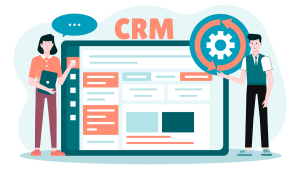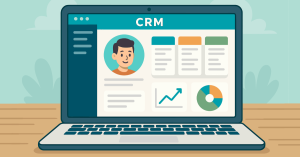Generating leads in the past may have looked like cold calls or emails to customers who have never been exposed to your brand. However, these tactics are proving to be outdated in many industries especially because there isn’t much solid ground to work from.
Instead, marketers are finding that the best strategy for generating leads is to meet them where they’re at. This means creating chance encounters through online ads, carving out paths through clever content, or using social media to attract interest. When you do this, you’ll find that your potential leads are much more open to learning more and hearing from you again.
What is Lead Generation?
Lead generation is characterized by all the marketing strategies and efforts that go into finding and obtaining quality leads that are placed into the buyer journey with conversion as the goal.
You’re trying to find potential customers and turn them into actual ones.
Why is Lead Generation So Important?
Lead generation is a high priority for any company. Sure, there are instances where people can stumble across your product or service without any prior knowledge and fall in love, but that’s not the best game plan for long-term sustainability of your company’s health.
For one, your sales team needs something to work on! Remember that your sales team and your marketing team are two completely different pieces of the puzzle. While your marketing team works on tactics for generating leads through content production, social media engagement, etc., your sales team needs quality leads to convert.
Leads are not going to show up out of nowhere, which means really homing in on your lead generation skills and strategy is what it will take to help you drive relevant traffic to your business. This isn’t about luck but, instead, a consistent, repeatable, and well-defined strategy that will expand your visibility and get the right people through the door.
How to Generate Leads
There are several ways to generate leads, but a majority will fall under one of two methods: outbound lead generation and inbound lead generation.
The difference between the two lies in the approach. Outbound lead generation focuses on outreach, getting directly in touch with potential customers. This looks like obvious strategies for reaching out like cold calling but can also be done in subtle ways like ads that address the potential lead without a salesperson getting in contact with them.
Inbound lead generation is the opposite. These are strategies where the company focuses on doing what they can to educate and engage with relevant audiences using their own platforms and sites. Plenty of organic and digital marketing strategies center around generating inbound leads through blogs, social media, and other channels.
The key to generating quality leads is knowing which tactic to deploy and when. While some businesses prioritize one kind of lead generation strategy over another, there isn’t a one-size-fits-all plan here. Taking a good look at your company’s personal budget, resources, and team capacity will help you be the judge of what brings you success while still being feasible.
How to Manage Leads
Once you have your leads, there’s also the question of where to store them. While “as colorful sticky notes on a lead gen inspiration board” sounds beautiful, that’s not the way we’d recommend going.
Instead, getting a good CRM system set up for your business is the best strategy. What’s even more powerful than the data it stores is the way a CRM helps you utilize the data and create processes that loop right back into lead generation. These days, a well-made and well-utilized CRM can help you meet your leads where they’re at which can be huge when it comes to reaching out to new customers.
What is a CRM System?
CRM stands for Customer Relationship Management, emphasis on “Relationship Management”. This means while, yes, it is used to store leads, it is also crucial to understand that its overall role lies in effectively managing the relationships between your company and your customers.
A CRM system is a tool that functions as a central source of truth for all of your customer data. It stores information from contact details to contact interactions which makes it really useful for creating personalized experiences for your leads and nurturing deep relationships.
In addition, it also helps your team efficiently organize tasks. It’s not just the customer activity that the system can track but the actions of team members too! This makes it easy for everyone to gauge a customer’s timeline and stay on track with pending tasks, share updates, and insert notes.
CRM Lead Management
A CRM system is powerful when it comes to lead generation, especially when you understand its capabilities. Not only does it help you capture and convert leads, but it also plays a role in retaining those leads for the future.
The functions of a CRM funnel directly into a lead generation process, helping you maximize your revenue potential and maintain a clear workflow. And, as we all know, efficient processes and organized action steps are significant contributors to a successful buying journey.
With a lead management system in place, you’ll be able to add leads directly from your site, personalize their experience, assign them to sales reps, and be notified of each step in the process. When it’s all said and done, and even when it is happening in real time, CRM also supplies you with the analytics and reporting you need to know exactly what’s happening and figure out why. Having software like this to take over data entry and tracking while also giving you quick ways to manage the process keeps you in tune with the progress of your leads.
Lead Generation Examples
Now that we’ve covered the details, let’s walk through an example of what this all looks like put together. Remember that buying habits have changed over time which means you’ll be deploying different strategies with the help of your CRM and marketing automation to adapt. These tools will help you structure buyer journeys and create and replicate moments of engagement and connection that reach your buyer at exactly the right time with the right content.
The journey begins when someone discovers your brand through some sort of marketing channel whether that’s your main website, through a blog, or on social media. If they take some sort of action towards interacting with your company or content, your marketing tools can track the encounter. Say they click on your call-to-action or fill out their contact information in exchange for a gated piece of content. These actions are all simple ways to create a new lead.
Common methods that marketing teams adopt include:
- Blogs. Unique content featured in blogs is a great way to attract new audiences who are looking for information but may not be aware of your brand. The nice thing about blogs is that you’re able to put in the research to tailor the topic towards your offerings or promotions that can redirect the attention to your brand.
- Email. Email is a no brainer option for reaching those who are already interested in your business. Tactful copy and well-placed CTAs are easy ways to get those that have acted in the past to do so again.
- Ads and Retargeting Ads. Ads have been used for generations to attract attention and they always manage to drum up some interest. Living in an age with neat tech advancements gives us the ability to target precise audiences and then retarget depending on the parameters we set.
- Social Media. These platforms make it especially easy these days for followers to follow up on what they see. From simple swipe ups to link taps, there are lots of ways to promote your business through the content you create.
Once they’re on your radar, you can use a variety of marketing strategies to continue to drive traffic to your content, products, or services, encouraging them to indulge in information you share or look into the types of services or products you offer. This part of the journey can look different for each lead but may start with a welcome message as well as follow-up emails to share details and check in.
While some leads move through the flow quickly and go in with the intention to convert once they feel satisfied with their choice, others will take some nurturing. Your CRM will let you know where each person is at throughout the process and your marketing automation workflow can use this data as a signal to deploy specific marketing campaigns. This may look like sharing how-to blogs that you’ve already produced or creating a chain of abandoned cart emails that include reminders and offers like free shipping or a coupon code.
The Takeaway
It’s been established that lead generation is huge for building a solid foundation to work from. These people impact the future of your company, so it makes sense why it is more important than ever to tailor your strategies to meet them where they’re at and to leverage CRM and marketing automation to streamline the process.
When talking about moving a prospect or lead on to the next stage, all actions can make a difference which makes inefficient, disorganized, or gap-filled processes risky to your success. Honestly, when in doubt, lean on your CRM to guide you through your decisions and you’ll be able to make the most of any sales approach.


